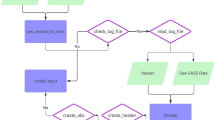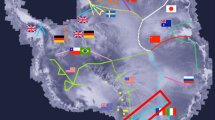Abstract
The Macrometer Model V-1000 is a geodetic positioning instrument that uses the radio signals broadcast by the GPS satellites. The Macrometer is the only GPS user equipment commercially available that does not require any of the GPS codes. The Model V-1000 receives only the 19-cm wavelength signals from GPS although similar instruments, built for the U.S. Air Force Geophysics Laboratory, receive both the 19-and the 24-cm wavelengths. In this paper we summarize the results of two years of field testing of the V-1000. This instrument, observing four or five satellites fof a few hours, yields a point position accurate within several meters in each coordinate: latitude, longitude and ellipsoidal height. All three components of the relative position vector between a pair of points can be determined within 2 parts per million of the distance, given a similar schedule of observations. This accuracy has been obtained for intersite distances from one kilometer to several thousand kilometers.
Similar content being viewed by others
References
Y. BOCK: “Centimeter-Level Baseline Estimation with GPS Interferometry,” accepted for publication inMarine Geodesy, 1983.
J.D. BOSSLER, C.C. GOAD and P.L. BENDER, 1980: “Using the Global Positioning System for Geodetic Positioning,”Bulletin Géodésique 54, p. 553–563.
J.T. CARR and J.W. O'TOOLE, 1982: “Point Positioning with the NAVSTAR Global Positioning System,”Proc. IEEE Symposium on Position, Location, and Navigation, Atlantic City, N.J., pp. 166–170.
C.C. COUNSELMAN, III, 1982: “The MacrometerTM Interferometric Surveyor,”Proc. Int. Symposium on L and Information at the Local Level, Univ. of Maine, Orono, pp. 233–241.
C.C. COUNSELMAN III and I.I. SHAPIRO, 1979: “Miniature Interferometer Terminals for Earth Surveying,”Bulletin Géodésique 53, pp. 139–164.
C.C. COUNSELMAN III and S.A. GOUREVITCH, 1981: “Miniature Interferometer Terminals for Earth Surveying: Ambiguity and Multipath with Global Positioning System,”IEEE Transactions Geoscience and Remote Sensing, GE-19, pp. 244–252.
C.C. COUNSELMAN III and D.H. STEINBRECHER, 1982: “The MACROMETER: A Compact Radio Interferometry Terminal for Geodesy with GPS,”Proc. Third International Geodetic Symposium on Satellite Doppler Positioning, Vol. 2, Physical Sciences Laboratory, New Mexico State Univ., pp. 1165–1172.
C.C. COUNSELMAN III, R.A. ABBOT, S.A. GOUREVITCH, R.W. KING and A.R. PARADIS, 1983: “Centimeter-Level Relative Positioning with GPS,”Journal of Surveying Engineering, 109 (ASCE), pp. 81–89.
P.J. FELL, 1980: “Geodetic Positioning using a Global Positioning System of Satellites,” Dept. of Geodetic Science Report 299, The Ohio State Univ., Columbus.
Federal Geodetic Control Committee (F GCC), 1980:Classifications, Standards of Accuracy, and General Specifications of Geodetic Control Surveys, Rockville, Maryland.
C.C. GOAD and W. REMONDI, 1984: “Initial Relative Positioning Results Using the Global Positioning System,”Bulletin Géodésique 58, pp. 193–210.
L. D. HOTHEM, 1979: “Determination of Accuracy, Orientation and Scale of Satellite Doppler Point-Positioning Coordinates,”Proc. Second International Symposium on Satellite Doppler Positioning, Vol. 3, The University of Texas at Austin, pp. 609–630.
L. D. HOTHEM and C. J. FRONCZEK, 1983: “Report on Test and Demonstration of MACRO-METERTM Model V-1000 Interferometric Surveyor,” Federal Geodetic Control Committee: FGCC-IS-83-2, Rockville, Maryland.
L.D. HOTHEM, 1983: “Analyses of Doppler, Satellite Laser, VLBI and Terrestrial Coordinate Systems,” Internal report, National Geodetic Survey, Rockville, Maryland.
J. KOUBA, 1983: “A review of Geodetic and Geodynamic Satellite Doppler Positioning,”Reviews of Geophysics and Space Physics, 21, pp. 27–40.
G. LACHAPELLE, N. BECK and P. HEROUX, 1982: “NAVST AR Single Point Positioning Using Pseudo-Range and Doppler Observations,”Proc. of Thrid International Geodetic Symposium on Satellite Doppler Positioning, Vol. 2, Physical Sciences Laboratory, New Mexico State Univ., pp. 1079–1091.
P.F. MACDORAN, 1979: “Satellite Emission, Radio Interferometric Earth, Surveying: SERIES-GPS Geodetic System,”Bulletin Géodésique 53, pp. 117–138.
Macrometrics, Inc. 1983:Macrometer Interferometric Surveyor 1000 Series Field Manual, 185 New Boston St., Woburn, Massachusetts 01801.
P. D. PERRAULT, 1983: “STI GPS Receivers”, inCSTG Bulletin No. 5, Technology, and Mission Developments, Dept. of Geodetic Science and Surveying, Columbus, Ohio.
W.J. SENUS, 1983: “NAVSTAR Global Positioning System Status” Proc. of the IAG Symposia, XVIII General Assembly, Hamburg, 1983, Vol. 2, Dept. of Geodetic Science and Surveying, Columbus, Ohio, pp. 184–191.
Author information
Authors and Affiliations
Additional information
Macrometer is a trademark of Aero Service Division, Western Geophysical Company of American, 8100 Westpark Drive, Houston, Texas, 77063, U.S.A.
Rights and permissions
About this article
Cite this article
Bock, Y., Abbot, R.I., Counselman, C.C. et al. Geodetic accuracy of the Macrometer model V-1000. Bull. Geodesique 58, 211–221 (1984). https://doi.org/10.1007/BF02520902
Received:
Accepted:
Issue Date:
DOI: https://doi.org/10.1007/BF02520902




